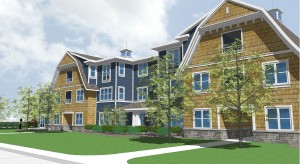Workforce Housing Goes Up in St. Michaels
Photo courtesy of Grimm + Parker Architects
Affordable housing in our region is a challenging issue. In this blog article, we offer the story of one of our towns trying to address it.
The Riverwoods at St. Michaels, a workforce housing development, will be completed in May. The development is slated to provide needed accommodation for some of the workforce population in our region. Given the town’s appeal to tourists and its plethora of high-value properties, affordable housing previously has been minimal. With the introduction of the Riverwoods development, the town hopes more workers will live downtown.
Housing prices and rental rates throughout the country have risen in the past decade, making it a challenge for lower-wage workers to live close to their area of employment or to afford owning a home.[1] An increased distance between workers and work has a negative effect on the community.
According to a report produced by the Joint Center for Housing Studies (JCHS) and the Center for Workforce Preparation (CWP), reducing workers’ commuting times contributes to their efficiency and productivity at work.[3] It also poses a critical question: “Are high housing costs undermining the type of competitive business environment that is essential to strong, vibrant communities? Should the increasing cost of housing therefore be added to the list of traditional business concerns?”[4]
In recent years, housing prices have risen faster than most incomes, making it difficult for workers to reconcile their cost of living with their distance/commute from work.[5] According to the JCHS and CWP report, “In Houston, Texas … the median price of a for-sale home in 2003 was $137,000, beyond the reach of elementary school teachers, nurses, retail salespersons, and janitors.”
Employers also struggle when their employees live far from work. Aaron Nelson of the Chapel Hill-Carrboro Chamber of Commerce commented on the drain this had on his town: “‘We lose out on volunteerism and retail dollars, we deal with traffic-related environmental damage, and we see wage inflation, because employers have to pay more to compensate people for their long commutes…”.[6]
A workforce housing program contributes to a town’s overall vibrancy. Creating and maintaining a close-knit downtown is more easily accomplished when all members of the community have access to the town center and can be involved members of society. More interests are represented in town decisions and more people have access to the benefits and conveniences of services (such as shopping, dining, parks, etc.). The inclusion of more community members strengthens cohesiveness and allows people with varied backgrounds to interact and learn from each other.
The Riverwoods at St. Michaels development is being built on the site of the previous Frederick Douglass school, an important piece of local history that will be honored in the new building with a dedication to Douglass (his name on the reading room, a statue, or similar tribute).[2]
Including such a feature and preserving this cherished legacy underscores a broader set of standards that should be considered in any new project when trying to promote town vibrancy. As a start, these can include:
- Design– the project should fit the functional and aesthetic expectations of new growth in the town.
- Location– the location of the complex should be appropriate for the size of the development.
- Access– the project should be conveniently placed within walking distance to public spaces (e.g., parks), central downtown, and the waterfront. Providing residents with access to primary amenities helps keeping the community intact and engaged.
- Heritage– with any new addition to a town, it’s important that it integrate smoothly with and complement the town’s heritage. The architectural style of the buildings should tie in nicely with the character and charm of the town.
- Scale– the project should be appropriately focused around resident needs and scaled to accommodate pedestrians and bikers. It shouldn’t overwhelm the community but rather be inclusive and serve a town’s needs.
When people live closer together, they rely more on walking and less on cars. Ideally, some residents would be able to walk or bike to and from work. Fewer cars on the road means less emissions, improved air quality, and enhanced street safety.
As Eastern Shore towns seek to become well-defined cultural and economic centers, investing in capacity and infrastructure will help entice and sustain a larger, non-transient population. This population, in theory, would contribute to increased business during “off-peak” times of the year, critical for tourist locations currently dependent on seasonal tourists.
St. Michaels’ foray into workforce housing will provide lessons for other towns about creating sustainable solutions to housing dilemmas.







